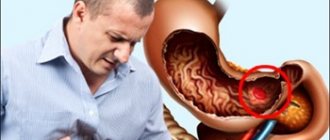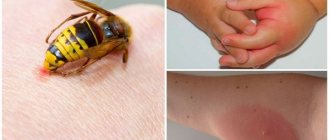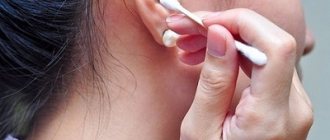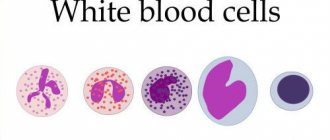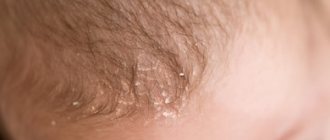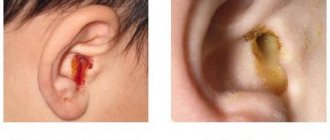Symptoms and clinical picture of lymphadenitis in children
Signs of lymphadenitis in children are expressed in a significant increase in lymph nodes (mainly cervical and submandibular), sometimes so much that it is visible to the naked eye. On palpation, the child feels acute pain, the outer skin is hyperemic.
Symptoms of lymphadenitis in children vary depending on its type.
General - there are signs of intoxication, fever, chills, deterioration in general health, drowsiness, weakness, dizziness, sweating, etc.
Purulent - the symptoms described above are even more pronounced, the skin in places of swelling is noticeably reddened, there is increased swelling and local pain.
Manifestations of lymphadenitis can acquire varying degrees of severity, depending on the patient’s age, complexity and duration of the disease (the acute period can last from 2 to 4 weeks).
Republican Children's Clinical Hospital
What is lymphadenopathy in a child? This is an enlargement of lymph nodes in one or more areas of the body due to a disease. What are they needed for? Lymph nodes are “customs” for a large area of the human body. Although these are small round formations the size of beans or peas, they are nevertheless intended to be the first barrier to pathogens of infectious diseases: bacteria, viruses, fungi, protozoa, preventing the spread of infection deep into the body. Therefore, lymph nodes are located singly or in groups, but always in strategically important places.
Lymphadenopathy is a symptom of the disease. Which one exactly? The doctor will answer this question. Unfortunately, this important symptom is not always assessed adequately and in a timely manner. Parents should know that if one or more enlarged lymph nodes are detected in one group, the child should be consulted with a pediatrician. In most cases, the cause of enlarged lymph nodes is infectious processes (viral, bacterial, fungal, protozoal), less often - autoimmune diseases, storage diseases. However, such causes can also be malignant neoplasms.
Among infectious causes, enlargement of lymph nodes is most often caused by staphylococcal or streptococcal infections - tonsillitis, pharyngitis, scarlet fever, complicated caries, boils, diseases of the upper respiratory tract, and less often - diphtheria, tuberculosis, plague. In this case, complaints, a thorough examination, medical history, analysis of Mantoux reactions and the vaccination calendar will help determine and prescribe treatment. Often the cause is “cat scratch” disease, when a child, a few days or even 2-3 weeks after a child has been scratched on the arms or legs by a tormented cat, the lymph nodes of the axillary or groin areas, respectively, enlarge and become painful. In this case, the doctor will prescribe adequate antibacterial therapy.
Among viral infections, one should think about rubella, chickenpox, mumps, cytomegalovirus, infectious mononucleosis, and HIV infection. To diagnose these conditions, an increase in body temperature, a rash on the skin and mucous membranes, pain when opening the mouth, puffiness of the face, snoring at night, purulent sore throat, and the presence of contacts with patients the day before will be important.
However, with this variety of causes, a doctor who is alert to cancer will identify a group of patients with suspected malignant tumor or blood disease and refer the child to an oncohematologist for consultation.
When treating cancer, early diagnosis is the most important step on the path to recovery. Treatment of a patient at the first stage is the most promising and cheapest. Unfortunately, many people are convinced that malignant tumors practically never occur in children. However, it is not. Being, fortunately, a fairly rare disease, malignant tumors rank second after injuries among the causes of death in children under 15 years of age. As data from statistical studies show, every year out of 100 thousand children of this age, 14-15 are diagnosed with malignant neoplasms.
Symptoms that should alert a child with lymphadenopathy include significant weight loss in a short time, persistent loss of appetite, bone pain, increased fatigue (the child gets tired faster than usual, forgetting even about his most favorite games), lethargy, pale skin, bruises on the body without obvious injuries, hemorrhages in the mucous membranes, unexplained rises in body temperature.
But despite the presence or absence of these symptoms in the child, parents should understand that until the reasons are determined, they should not warm the lymph nodes, carry out any physical procedures (electrophoresis, applications, etc.), or lubricate them with anything. Any physical procedures on the area of the lymph nodes are contraindicated, as they can aggravate the process, causing rapid progression and thus reducing the chances of recovery with even more expensive treatment. There are cases when such errors became fatal.
Thus, the attentiveness and prudence of parents plays a huge role in timely diagnosis and initiation of treatment. Who, if not parents, will be able to notice changes in their child’s condition in time - and contact specialists in time, without making mistakes along the way? As American oncologist Charles Cameron wrote: “Be neither too careless about the possibility of cancer in children nor too worried. But be on your guard!”
| Pediatric hematologist, KRU "DKB" | Tarasenkova A.A. |
Answer
Basic treatment methods and contraindications
Treatment is carried out using an integrated approach and conservative methods of therapy.
The following medications are prescribed:
- antibiotics of narrow or broad spectrum of action;
- probiotics - to preserve intestinal microflora;
- antihistamines - to prevent allergic reactions and reduce tissue swelling.
Physiotherapeutic methods are represented by UHF and EHF therapy, which has an anti-inflammatory and antiseptic effect.
Severe infections may require surgery.
Contraindications:
- suspicion of the presence of a tumor formation;
- Do not apply warm compresses or heat areas of swelling.
General information
The organs of the lymphatic system play a protective role in the human body. They serve as a barrier to viruses, bacteria, and also filter out harmful substances. In total, there are more than 450 lymph nodes in the adult body, and their maximum number is formed by the age of 10.
Lymph nodes are connected by lymphatic vessels - lymph (a fluid with a high content of lymphocytes, or “white blood cells”) circulates through them. Produced in the bone marrow, lymphocytes circulate throughout the body, first passing through the spleen and then the lymph nodes. Thanks to this, they gain the ability to produce antibodies to destroy microbes. Source: A.G. Rumyantsev, professor, V.M. Chernov, professor, V.M. Delyagin, professor Enlarged lymph node syndrome as a pediatric problem Practical Medicine, 2007, No. 5 (24), pp. 12-15
When an infection enters , a kind of “attack” is carried out on it, as a result of which the lymph nodes can enlarge (during this period they more actively produce antibodies). After recovery, the nodes return to normal size. If their diameter and density do not return to their original state, the child must be shown to a doctor.
Diagnostic methods
After examination and collection of complaints and medical history, the specialist sends the child for a general examination . It includes x-rays, blood and urine tests . Additionally, the following studies may be needed:
- blood serology;
- diagnosis of tuberculosis;
- lymph node biopsy followed by cytological examination in the laboratory;
- Ultrasound.
Sometimes children are prescribed antibacterial drugs as part of the diagnosis. Based on their effectiveness, they confirm or refute the bacterial nature of the disease.
Causes of enlarged lymph nodes in a child
If your doctor suspects that your lymphadenopathy is not the result of an infection, the first step is to perform a physical examination and take a detailed medical history. Hard, dense nodes that do not move under the fingers will be the basis for referring the child for laboratory tests, possibly also for imaging. Only if the test results are concerning, the doctor will order a histopathological examination.
Basically, there can be two reasons for enlarged lymph nodes in a child. The first is the proliferation of nodal cells, mainly lymphocytes. The second reason is infiltration caused by foreign cells - inflammatory and malignant. Neoplastic diseases that present with lymphadenopathy include lymphocytic lymphoma and Hodgkin lymphoma. However, cancer is not the main cause of enlarged lymph nodes. More often, lymphadenopathy is caused by: - viral infections;
- allergies; — vaccination; - autoimmune diseases.
Enlarged lymph nodes in a child's neck
Enlarged lymph nodes in a child's neck are of greatest concern to parents and doctors because they may be a sign of Hodgkin's lymphoma. The disease most often occurs in adolescent children, less often in young children. In most cases, the cause of enlarged nodes in the neck is viral infections, incl. mononucleosis, that is, a disease caused by the EBV virus, and bacterial - inflammation of the tonsils and throat.
In the case of lymphadenopathy located in the neck, you can be sure that the pediatrician will prescribe basic diagnostic tests, incl. blood analysis.
However, it is worth considering that an increased level of lymphocytes in a child under 6 years of age is perceived as normal. Doctors call this physiological lymphocytosis. Additionally, you should be aware that the standards set by the laboratory apply to adults, so any test results should be discussed with your pediatrician. Comparing the data to the standards provided by the laboratory is not sufficient to correctly interpret a child's test results.
Advantages of contacting SM-Clinic
“SM-Clinic” is a team of some of the best specialists in St. Petersburg, advanced diagnostic equipment and comfortable conditions. We have no queues, all examinations are carried out quickly, appointments are conducted by highly qualified doctors.
If your child has enlarged lymph nodes in the neck or in any other area, you should urgently contact a specialist for diagnosis and treatment. Delay in some cases is very dangerous!
To make an appointment with a pediatrician, immunologist or other pediatric specialist, call us.
Sources:
- A.G. Rumyantsev, professor, V.M. Chernov, professor, V.M. Delyagin, professor. Syndrome of enlarged lymph nodes as a pediatric problem // Practical Medicine, 2007, No. 5 (24), pp. 12-15.
- N.V. Nagornaya, E.V. Vilchevskaya, A.P. Luachak, E.N. Marchenko, E.V. Bordyugova, A.P. Koval. Hodgkin's disease (lymphogranulomatosis) in children // Child's Health, 2013, No. 1 (44), pp. 13-15.
Grek Elena Anatolyevna Clinic
Author of the article
Grek Elena Anatolyevna
Doctor of the highest qualification category
Specialty: immunologist
Experience: 23 years
The information in this article is provided for reference purposes and does not replace advice from a qualified professional. Don't self-medicate! At the first signs of illness, you should consult a doctor.
Prices
| Name of service (price list incomplete) | Price |
| Appointment (examination, consultation) with an allergist-immunologist, primary, therapeutic and diagnostic, outpatient | 1750 rub. |
| Consultation (interpretation) with analyzes from third parties | 2250 rub. |
| Prescription of treatment regimen (for up to 1 month) | 1800 rub. |
| Prescription of treatment regimen (for a period of 1 month) | 2700 rub. |
| Consultation with a candidate of medical sciences | 2500 rub. |
| Allergen-specific immunotherapy (ASIT) - maintenance course (excluding the cost of the drug) | 8100 rub. |
Indicators of normal lymph nodes:
- diameter up to approximately 5 mm;
- soft consistency;
- single location, that is, lack of connection with each other or with the skin;
- absence of pain upon palpation (palpation);
- mobility.
Reasons for enlargement and main groups of lymph nodes
| Group of lymph nodes | Typical reasons for the increase |
| Parotid | Pyoderma (inflammation of the scalp accompanied by pus), inflammation of the outer or middle ear, the presence of lice, atopic dermatitis, eczema. |
| Occipital | Various inflammations in the scalp, fungal diseases, rubella, etc. |
| Submental | Abscess of the jaw, inflammation of the lower lip, damage to the front teeth, stomatitis. |
| Submandibular | Gingivitis, stomatitis, dental damage. |
| Cervical (in the direction of the muscles at the back of the neck) | Sore throat, chronic tonsillitis, tuberculosis of the tonsils, adenoids, infectious form of mononucleosis. |
| Cervical (middle) | Scarlet fever, tonsillitis, “cat scratch disease”, Hodgkin or non-Hodgkin lymphoma ( important - these are malignant oncological processes!), toxoplasmosis. |
| Cervical (lateral) | Tumors, lymph node tuberculosis, nasopharyngeal infections. |
| Elbow | Infections of the forearm or hand. |
| Axillary | Shoulder or arm infections, vaccine reactions, cat scratch disease. |
| Inguinal | Infections of the skin, bones and muscles of the lower extremities, inflammation of the joints, dermatitis, inflammatory processes in the genitals, reaction to a vaccine introduced into the femoral area. |

